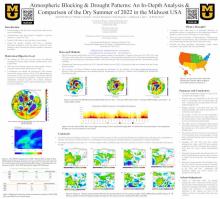Atmospheric Blocking and Drought Patterns: An In-Depth Analysis and Comparison of the Dry Summers of 2022 and 2023 in the Midwest USA
Sarah
Weaver
University of Missouri
Poster
The summer of 2022 experienced significant dryness across Missouri and surrounding regions including the Great Lakes, Midwest, and southern plains of the USA. This pattern was similar to the dry summer of 2012, which was marked by a strong 500 hPa height anomaly over the western US and plains, alongside minimal atmospheric blocking in the East Pacific. In contrast, the summers of 2018 and 2021 exhibited more zonal flow across the USA and increased East Pacific blocking, aligning with findings from previous studies.
Atmospheric blocking plays a crucial role in determining regional weather patterns, including the occurrence of droughts. In the context of the 2023 drought in the Midwest, understanding the role of atmospheric blocking is essential. During the summer of 2023, similar atmospheric conditions to those in 2012 were observed, with significant atmospheric blocking impacting the weather patterns. This blocking likely contributed to the persistent high-pressure systems in the region, leading to reduced rainfall and higher temperatures, thus creating the conditions for a drought.
Additionally, the Climate Prediction Center's teleconnection indexes and the blocking archive at the University of Missouri provide insights into these weather patterns. For both the drier years of 2012 and 2022, these indexes showed similarities, whereas they differed significantly during the wetter years of 2018 and 2021. The surface conditions mirrored these patterns, with drier years exhibiting similar characteristics and wetter years showing opposite trends.
Furthermore, the integrated enstrophy (IE) metric, used in previous studies, identified a shift in the large-scale flow regime in early June 2022. This shift coincided with a decrease in precipitation over the study region. However, an interesting anomaly was noted in the spring of 2022, which exhibited blocking more consistent with a wetter summer. This inconsistency highlights the complexity and unpredictability of meteorological phenomena and the challenges in forecasting events like the drought of summer 2023 in the Midwest.
In summary, the drought of summer 2023 in the Midwest can be meteorologically attributed to conditions similar to those in 2012, characterized by strong atmospheric blocking and high-pressure systems that limited rainfall and increased temperatures, leading to the dry conditions experienced across the region.
Atmospheric blocking plays a crucial role in determining regional weather patterns, including the occurrence of droughts. In the context of the 2023 drought in the Midwest, understanding the role of atmospheric blocking is essential. During the summer of 2023, similar atmospheric conditions to those in 2012 were observed, with significant atmospheric blocking impacting the weather patterns. This blocking likely contributed to the persistent high-pressure systems in the region, leading to reduced rainfall and higher temperatures, thus creating the conditions for a drought.
Additionally, the Climate Prediction Center's teleconnection indexes and the blocking archive at the University of Missouri provide insights into these weather patterns. For both the drier years of 2012 and 2022, these indexes showed similarities, whereas they differed significantly during the wetter years of 2018 and 2021. The surface conditions mirrored these patterns, with drier years exhibiting similar characteristics and wetter years showing opposite trends.
Furthermore, the integrated enstrophy (IE) metric, used in previous studies, identified a shift in the large-scale flow regime in early June 2022. This shift coincided with a decrease in precipitation over the study region. However, an interesting anomaly was noted in the spring of 2022, which exhibited blocking more consistent with a wetter summer. This inconsistency highlights the complexity and unpredictability of meteorological phenomena and the challenges in forecasting events like the drought of summer 2023 in the Midwest.
In summary, the drought of summer 2023 in the Midwest can be meteorologically attributed to conditions similar to those in 2012, characterized by strong atmospheric blocking and high-pressure systems that limited rainfall and increased temperatures, leading to the dry conditions experienced across the region.

Poster file
Weaver_Sarah_blocking_poster.pdf
(1.13 MB)
Meeting homepage
